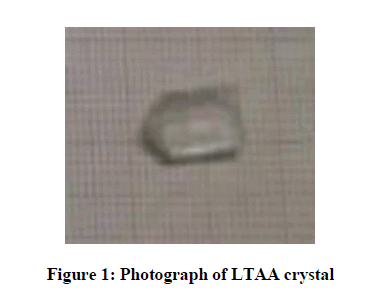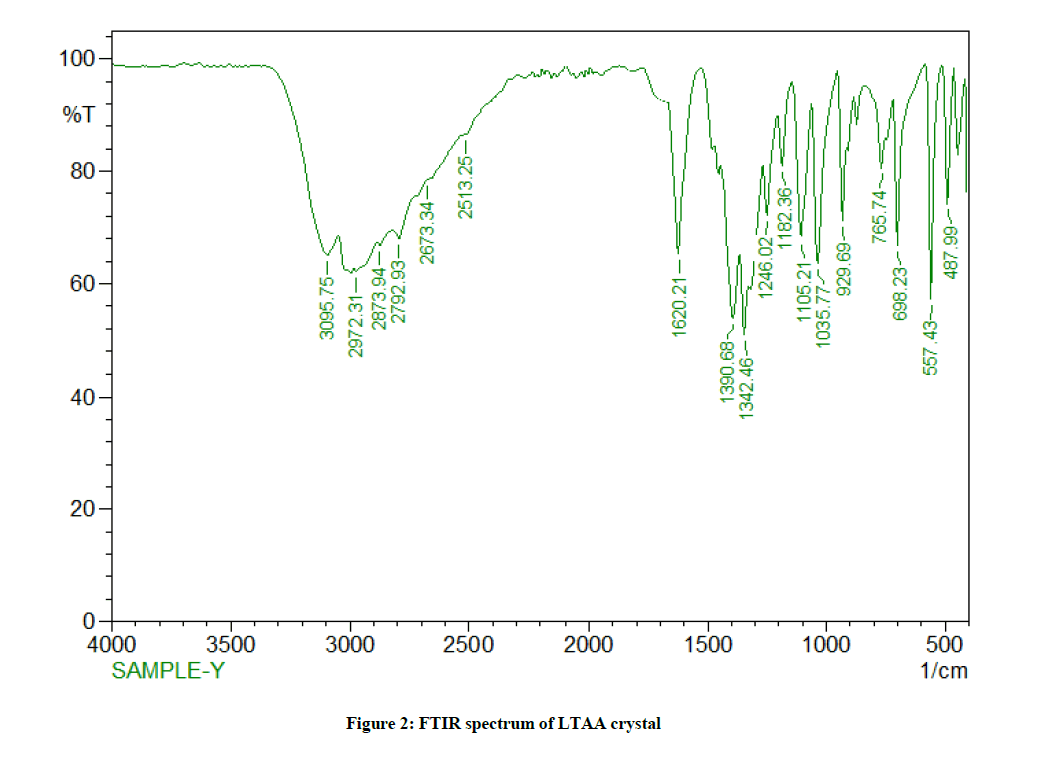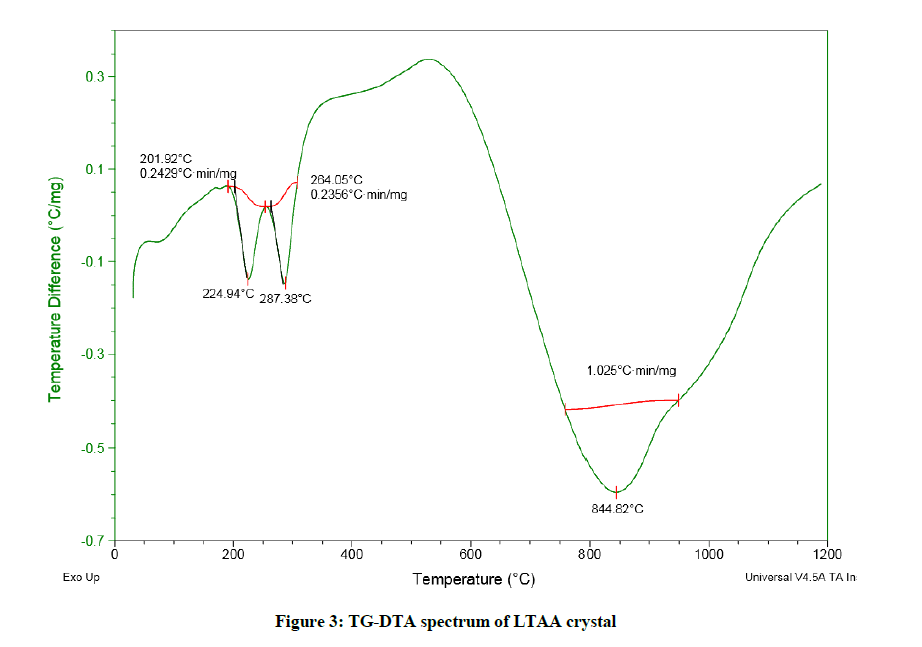Research Article - Der Pharma Chemica ( 2018) Volume 10, Issue 10
FTIR, Thermal and NLO Studies on L-Threonine Ammonium Acetate
Kavitha T1, Pasupathi G2 and Kanagathara N3*
1Department of Physics, Arasu Engineering College, Kumbakonam-612501
2PG and Research Department of Physics, AVVM Sri Pushpam College (Autonomous), Poondi, Thanjavur-613 503, Tamilnadu, India
3Department of Physics, Saveetha School of Engineering, Saveetha Institute of Medical and Technical, Thandalum, Chennai-602 105, India
- *Corresponding Author:
- Kanagathara N
Department of Physics
Saveetha School of Engineering
Saveetha Institute of Medical and Technical
Thandalum, Chennai-602 105, India
Abstract
A semi organic L–Threonine Ammonium Acetate (L-HAA) crystal has been grown at room temperature by using slow evaporation technique. Single crystal X-ray diffraction analysis reveals that the grown crystal crystallizes in the non-centro symmetric space group C2 of tetragonal crystal system. Infrared spectral analysis has been done to confirm the presence of functional groups in the grown crystal. Thermo gravimetric analysis reveals that the grown crystal is thermally stable upto 201ºC. The second harmonic generation output intensity was confirmed using the Kurtz and Perry powder method and it is found to be 0.986 times lesser than that of KDP.
Keywords
XRD, TG-DTA, SHG.
Introduction
Progress in science of crystal growth has made great revolution in many fields like microelectronics, computer industries etc. The utility of crystals are the backbone of the modern technology and has been extended for several useful applications in optical, electrical and optoelectronic devices. Researchers are concentrating on growing large sized single crystals in short duration with less cost for device fabrication. Nonlinear optical (NLO) materials are expected to play a major role in photonics including sensors, data storage, optical information processing etc. Progress in these areas would be highly intensified by the materials with sufficient large NLO efficiency for various device embodiments. Amino acids are bi-functional organic molecules find its applications in non-linear optical field due to its zwitter ionic nature [1]. L-threonine is one such amino acid consists of consist of deprotonated carboxylic acid (COO-) and protonated amino group (NH3+) and the crystal structure was first solved by Shoemaker et al. [2]. In the present communication L-threonine is taken up the subject of interest. Janczak et al. reveals that L-threonine crystallizes in non-centrosymmetric P212121 space group with 4 zwitter ionic molecules in the unit cell linked by a 3-dimentsional network of hydrogen bonds of unequal strength [3]. The attempt has been made by many researchers to study the non-linear optical properties of amino acid [4-9]. Ammonium acetate is an important intermediate and catalyst for many chemical reactions also associated with its toxicities like flaccidity of facial muscles, generalized discomfort, tremor, anxiety, and impairment of motor performance [10]. It serves as a nutrient material like food additive, antidiuretic and aqueous buffer for proteins [11-14]. Trivedi et al. studied the vibrational spectral analysis of ammonium acetate [15]. Recently Joshi et al. has studied the effect of L-threoniine on ADP single crystals and they confirms that the second and third harmonic generation efficiency is double that of KDP [16]. As far as all the authors knowledge concerned, this is for the first time we report the vibrational, thermal and non-linear optical properties of L-threonine ammonium acetate single crystal. Figure 1 shows the photograph of the grown crystal.
Materials and Methods
Experimental procedure
Synthesis and crystal growth
The calculated amounts of the AR grade starting materials are L-Threonine and Ammonium Acetate are taken in equal molar ratio were dissolved in Millipore water. The mixture is thoroughly stirred well for 5 hours to get the homogenous solution. The chemical reaction is given below,
C4H9NO3 + C2H7NO2 → NH4+ [C4H9NO3] CH3COO-
Then the solution is filtered and allowed to evaporate slowly at room temperature. After the period of 28 days, a colorless and optically transparent crystal of L–threoninium Ammonium Acetate (LTAA) is obtained.
Results and Discussion
Single crystal X-ray diffraction studies
The crystal structure of the grown L-Threonine Ammonium Acetate (LTAA) is studied by using an ENRAF NONIUS CAD4-F diffractometer with MoKα radiation (λ=0.71073 Å). Single crystal XRD reveals that LTAA crystallizes in non-centrosymmetric space group C2 with tetragonal crystal system. The obtained lattice parameters are determined a=12.083 Å, b = 12.083Å, c=3.620Å, α=γ=β=90o and volume of the unit cell V=900(Å).
Fourier transform infrared spectral analysis
The FT- of ammonium acetate were appeared at 1660-1702 cm-1 [17], the medium strong peak at 1342 and 1246 cm-1 is ascribed at C-H bending IR spectrum was recorded in the region 4000-400 cm-1 using Perkin Elmer spectrophotometer by KBr pellet method. Figure 2 shows the FT-IR spectrum of LTAA crystal. The IR peaks of ammonium acetate occur in the region 3024-3586 cm-1 for N-H symmetric stretching of NH4 group [15]. This peak is observed at 3095 cm-1 with medium strong intensity. The symmetric stretching of CH3 vibration is occurs at 2873 m-1 [8]. The C-H stretching vibration occurs at 2792 and 2673 cm-1 [8]. The C=O asymmetrical stretching vibration [18]. The strong peak at 1182 and 1105 cm-1 is assigned to NH3 rocking vibration. The medium peak at 1035 cm-1 is attributed to C-N stretching [19] and the peak at 929 cm-1 is assigned to C-C-N bending vibration. The peak at 765, 698 and 557 cm-1 is assigned to CO2 vibration.
Thermal studies
The thermal stability of the crystal was determined by thermo gravimetric analysis using SDT Q 6000 V 8.2 Built 100 thermal analyzer in the nitrogen atmosphere in the temperature range of 30oC-1000oC at a heating rate of 20oC/min. TG-DTA for the grown crystal is shown in Figure 3. The major weight loss occurs at three stages. The TGA trace shows, there is no weight loss below 201.92ºC which shows that the material is highly stable. First stage weight loss is observed between 200.5ºC to 250ºC is due to the decomposition of L-Threonine. Second stage weight loss is observed between 250ºC to 264ºC this is due to step by step decomposition and release of volatile substances in the compound, probably ammonia and carbon dioxide. The third stage gradual weight loss is observed for wider range of temperature between 780ºC to 950ºC is due to the decomposition of Ammonium acetate. These three different stages weight loss indicates the decomposition of the substance. The TG-DTA result shows that the material is thermally stable up to 200ºC and establishes its suitability to with stand the high temperature for laser experiments [20,21].
Non-linear optical studies
Kurtz and Perry powder technique was used to confirm the nonlinear optical (NLO) property of LTAA single crystal. A wavelength of 1064 nm with pulse width 8 ns Q - switched Nd: YAG laser source emitting was used to illuminate the sample. The second harmonic generation property of the grown crystal is confirmed with emission of green. The input energy incident on the sample was 0.70 mJ / pulse and the corresponding output was measured as 8.82 mJ. This output was compared with the output (8.94 mJ) obtained from KDP. The result shows that ammonium acetate increases the second harmonic generation efficiency of L-Threonine and is found to be 0.986 times that of KDP [19].
Conclusion
L–Threonine Ammonium Acetate (LTAA)-an organic non-linear optical single crystal has been successfully grown at room temperature by slow evaporation method. Powder X-Ray diffraction studies confirm the crystalline nature of the grown crystal. The single crystal X-ray diffraction depicts that grown crystal belongs to tetragonal system with space group C2. The various functional groups present in LTAA have been identified by Fourier Transform Infrared spectroscopy (FTIR) analysis. The thermal stability of the grown material is 200ºC which establishes its suitability to with stand the high temperature for laser experiments. The SHG efficiency of the grown crystal is found to be 0.986 times lesser that of the reference material KDP. Thus all the above results predict that LTAA crystal can be used as a potential candidate for non-linear optical applications.
References
- F. Yogam, I. Vetha Pother, A. Cyrac Peter, S. Tamilselvan, A. Leo Rajesh, M. Vimalan, P. Sagayaraj, Adv. Appl. Sci. Res., 2011, 2(1), 261-268.
- D.P. Shoemaker, J. Donohue, V. Schomaker, R.B. Corey, J. Am. Chemical Soc., 1950, 72(6), 2328-2349.
- J. Janczak, D. Zobel, P. Luger, Acta Crystallographica C., 1997, 53(12), 1901-1904.
- D. Subashini, A.R. Prabhakaran, S. Nalini Jayanthi, K. Thamizharasan, Adv. Appl. Sci. Res., 2013, 4(2), 238-242.
- A. Shanthi, C. Krishnan, P. Selvarajan, Physica. Scripta., 2013, 88(3), 035801.
- G. Thilakavathi, R. Arun Kumar, A. Kumaresh, N. Ravikumar, Mater. Res. Innov., 2016, 20(4), 254-258.
- G. Ramesh Kumar, S. Gokul Raj, R. Mohan, R. Jayavel, Crystal Growth & Design., 2006, 6(6), 1308-1310.
- G. Ramesh Kumar, S. Gokul Raj, Adv. Mate. Sci. Engg., 2009, 2009, 1-40.
- D. Subashini, A.R. Prabhakaran, S. Nalini Jayanthi, K. Thamizharasan, Adv. Appl. Sci. Res., 2013, 4(2), 238-242.
- R. Subhashini, D. Sathya, V. Sivashankar, P.S. Latha Mageshwari, S. Arjunan, Optical Materials., 2016, 62, 357-365.
- S. Budavari, The Merck Index: An encyclopedia of chemicals, drugs and biologicals. Merck and Co. Inc., Rahway, NJ, USA, 1989.
- L. Ding, W. Tan, Y. Zhang, J. Shen, Z. Zhang, J. Chromatogr. Sci., 2008, 46, 445-449.
- I.S. Rossoff, Handbook of Veterinary Drugs: A Compendium for Research and Clinical Use. Springer Publishing Company, New York, USA, 1974.
- A. Thellend, P. Battioni, D. Mansuy, J. Chem. Soc. Chem. Commun., 1994, 10351036.
- Mahendra Kumar Trivedi, Alice Branton, Dahryn Trivedi, Gopal Nayak, Khemraj Bairwa, Snehasis Jana, Mod. Chem. Appl., 2015, 3(3), 1-6.
- J.H. Joshi, S. Kalainathan, D.K. Kanchan, M.J. Joshi, K.D. Parikh, Arabian J. Chem., 2017.
- M. Nagarajan, N. Neelakanda Pillai, Dr. S. Perumal, IJLTEMAS., 2015, 4(11).
- A.D. Christopher, N. Neelakanda Pillai, Int. J. Eng. Sci., 2015, 4(8), 1-4.
- N. Indumathi, K. Deepa, S. Senthil, IJEDR., 2017, 5(1), 560-564.
- S.A. Martin Britto Dhas, S. Natarajan, Opt. Commun., 2008, 281, 457-462.
- A. Ben Ahmed, H. Feki, Y. Abid, Boughzala, A. Mlayah, J. Molecul. Struc., 2008, 888, 180-186.






